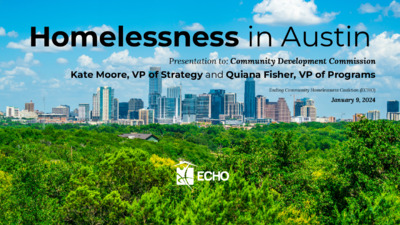Item2-CDC-ECHO-PPT-1.9.24 — original pdf
Backup

Homelessness in Austin Presentation to: Community Development Commission Kate Moore, VP of Strategy and Quiana Fisher, VP of Programs Ending Community Homelessness Coalition (ECHO) January 9, 2024 Agenda About ECHO Scope of Homelessness in Austin/Travis County Challenges: The landscape in Austin/Travis County Causes and Risk Factors Solutions to Homelessness About ECHO ECHO's Roles Coordinates community-wide, data-driven strategies and funding to end homelessness Collaborates with direct service providers who are connecting people with housing and supportive services Administers person-level community database to track demographics and service needs over time Scope of Homelessness Scope of Homelessness Scope of Homelessness Homelessness in Austin Demographics (HMIS data) In 2021, Austin's unhoused population was: Disproportionately Black (32%) Majority male (58.2%) Mostly single households (84.7%) Mostly born/raised or last permanently housed in Austin (63%) Additional Resources 2022 Racial Disparities Report 2022 Needs & Gaps Report Blog Post | Five Takeaways: Racial Disparities and Needs & Gaps in Austin's Unhoused Community People Experiencing Homelessness Travis County Population Challenges Housing Market Limited capacity and increasingly unaffordable Resulting in bottlenecks in our system People experiencing homelessness often wait months before moving into housing Prolonged unsheltered homelessness compounds the problem: Negative, potentially life-threatening health outcomes Harder to end someone's homelessness Response system plays catch-up on an ever-increasing backlog of people in need of housing, slowing progress toward ending homelessness Challenges Causes of Homelessness Causes vs. Risk Factors Everyone has a certain level of risk of homelessness Life challenges can add to a person's risk, including: Death of a family member Mental health obstacles Domestic violence Medical bills Substance abuse Job loss Many people remain stably housed forever with some combination of these risk factors Individual circumstances are unique, but every person experiencing homelessness has one thing in common: nowhere to live What causes homelessness is a lack of housing Causes of Homelessness Lack of Housing External to Homelessness Response System: Lack of Affordable Housing Rising rents & occupancy rates Low, stagnant wages Internal to Homelessness Response System Thousands of units shy of need Mostly scattered-site, not site-based, so subject to rental market forces like any renter Recent gains are steps in the right direction Additional Resources Out of Reach: The High Cost of Housing The Gap: A Shortage of Affordable Rental Homes Causes of Homelessness Systemic Racism Black Austinites are six times more likely to experience homelessness than white Austinites Due to systemic racism in housing, healthcare, education, policing, employment, & many more Black & Brown Austinites tend to be younger when they experience homelessness Indicates it takes Black & Brown people less time to suffer enough setbacks to end up unhoused Solutions to Homelessness Housing First National best practice model for connecting people to stable places to live A set of principles that conveys: Housing is a basic human right, not a privilege or a reward for good behavior Not housing only - prioritizes housing paired with supportive services, tailored to an individual's needs, that contribute to long-term success Studies show Housing First programs connect people more quickly to housing, help them remain stable longer, and save on public costs Additional Resources What Housing First Really Means 12 Month Return on Investment: Integral Care Terrace at Oak Springs How Houston Moved 25,000 People From the Streets Into Homes of Their Own When you’re drowning, it doesn’t help if your rescuer insists you learn to swim before returning you to shore. You can address your issues once you’re on land. Or not. Either way, you join the wider population of people battling demons behind closed doors. Solutions to Homelessness Emergency Shelter Austin had about 1,100 beds dedicated to Emergency Shelter, Safe Haven, and Transitional Housing in January 2022 People in these programs are still experiencing homelessness Austin shelters now using housing-focused case management model to increase housing connections New types of non-congregate shelter coming online Esperanza Community (The Other Ones Foundation) City of Austin bridge shelters Important interventions, but not solutions to homelessness Solutions to Homelessness Scaling the Solution In January 2023, there were about 4,000 total permanent housing units in system, majority occupied Thousands more people needed a place to live that day and didn't get one Additional 1000+ Permanent Supportive Housing (PSH) units in pipeline through 2025 For more data: austinecho.org/dashboard